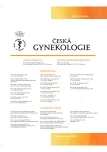Assisted reproduction trends in Czech Republic National Assisted Reproduction Register 2007–2017
Authors:
K. Řežábek
Authors‘ workplace:
Gynekologicko-porodnická klinika 1. LF UK a VFN, Praha, přednosta prof. MUDr. A. Martan, DrSc.
Published in:
Ceska Gynekol 2020; 85(1): 4-10
Category:
Overview
Objective: Find trends in assisted reproduction (AR) in Czech Republic (CR) in years 2007–2017.
Design: Retrospective national epidemiologic study.
Settings: Department of Obstetric and Gynaecology, 1st Faculty of Medicine, Charles University and Genereal University Hospital, Prague.
Methods: Data analysis of Czech Republic National Assisted Reproduction Register (NRAR) in years 2007–2017.
Results: Analyses of NRAR show mild, but permanent growth of AR cycles in CR (42 773 in 2017), as well as the nubmer of AR centers (43 in 2017). Important part of AR in CR are Egg Donation cycles (5003 in 2017) and Oocyte Receipt cycles (6057 in 2017). Fertilisation by ICSI is permanently growing (96% cycles in 2017). CR succeeded in decreasing in the number of transferred embryos (average1, 18 embryo in 2017 for women up to 35 years) with the aim to prevent multiple pregnancies. AR efficacy can be evaluated by several indicators, and the age is the main parameter – since 32 years the fertility of women is diminishing.
Conclusion: Czech national assisted reproduction register provides detailed information about AR treatment and enables qualified decisions for Ministry of Health, health insurances, treatment doctors and patients.
Keywords:
Czech Republic – IVF
Sources
1. Řežábek, K., Pohlová, R. Asistovaná reprodukce v České republice 2017. Praha: Ústav zdravotnických informací a statistiky České republiky.
2. Zegers-Hochschild, F., Adamson, GD., Dyer, S., et al. The international glossary on infertility and fertility care, 2017. Hum Reprod, 2017, 32(9), p. 1786–1801.
Labels
Paediatric gynaecology Gynaecology and obstetrics Reproduction medicineArticle was published in
Czech Gynaecology

2020 Issue 1
Most read in this issue
- Thrombotic microangiopathy and pregnancy
- Lactobacillus crispatus dominant vaginal microbita in pregnancy
- Noninvasive prenatal testing: benefits and limitations of the available tests
- Can we prevent ovarian cancer?
